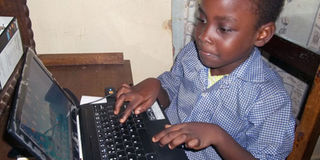Solar laptops project to cost Sh200bn

PHOTO | ROBERT NYAGAH Natasha Wakesho, 9, a standard three pupil at Upweoni Primary School in Malindi, with her father’s mini laptop at their Ngala Estate on April 13, 2013.
What you need to know:
- Only five per cent of public primary schools in Kenya have computers
Providing solar-powered laptop computers to pupils in public primary schools could cost taxpayers as much as Sh200 billion, about three quarters of the annual education budget.
In the first phase of the ambitious plan expected to kick off in January next year, the government will spend Sh25 billion to provide an estimated 700,000 children joining Standard One with the computers, according to data from the Ministry of Education.
A solar-powered laptop retails at Sh35,000. The Treasury has indicated that it expects to buy the computers at between Sh8,500 and Sh12,750.
According to education lobby group Uwezo Kenya, only five per cent of public primary schools in the country (estimated at 27,000) have computers, and about half of the teachers are computer-illiterate.
“The first question therefore is, will the laptop be a toy or a learning tool or both, and will it be for school or home use?” asked Dr John Mugo, Uwezo Kenya’s coordinator. “Who will guide these Class One pupils on how to use the laptops?”
Poorly trained
Another survey by the Association of Professional Teachers (Tap) in Nairobi last year indicated that the ability of the teachers to use computers was low, and the rate at which the computers were used in the course of teaching was equally low.
Tap’s audit report said that “teachers are poorly trained in basic computer programmes that are vital in the execution of their duties”.
The research was conducted in 10 districts around Nairobi, meaning that the situation could be worse in the schools deep in the rural areas.
“First, the group advising the President on implementing this project must include persons with the critical skills of information technology on the one hand, and educationists with good grounding on digital learning in contexts of developing countries, on the other,” Dr Mugo said.
“Second, this group of experts must inform themselves accordingly, on models that have been proposed for digital learning in similar contexts, to avoid making mistakes others have already made,” he added.
Besides that, the laptop computers to be provided are said to be loaded with the relevant curriculum content, yet the institute of curriculum development is yet to complete digitising the same content.
There has been systematic piloting projects done by the curriculum developer recently in Forms Three and Four at the secondary schools to test the digital curriculum.
At the end of it all, funding for the education sector will be pushed to over 40 per cent of the country’s budget, because of provision of such laptop computers.
This ambitious project will however put the priority of the government on education on the spotlight following recent reports that 1.8 million children are still out of school.
Privileged position
According to a joint report released by the United Nations and the government last year, 57 per cent of the children who have never been to school are girls, with boys still enjoying a privileged position in terms of access to education and life opportunities.
The figure remains high despite the introduction of free primary education in 2003, with the sector gobbling up nearly one third of the national budget.
Although the free primary education programme brought on board many boys and girls formerly locked out of education, the government’s inconsistency in disbursing the funds has hugely affected enrolment.
Each child under the free primary education programme is allocated slightly more than Sh1,000 per year to cater for all their learning needs.
At the secondary school level, each student is allocated Sh10,265 per year.
These amounts, have never been reviewed nearly a decade since the launch of the free primary education programme and the secondary plan in 2008, despite inflation and the rising cost of goods.
There is also the acute shortage of teachers in the public schools standing at more than 80,000 teachers countrywide.




